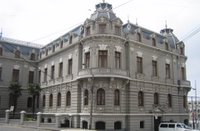Valparaiso, Chile
Visited November 20, 2005
Valparaiso (“Valpo” for short), Chile’s second largest city, clings to 45 foothills of a semicircular spur of Chile’s coastal range, descending abruptly to what was once one of the Pacific’s dominant ports. So steep are these hills that a set of fifteen funiculars – called “ascensores” shuttle residents and tourists up and down. We began our visit with a ride up the Ascencor Concepcion, the oldest elevator (it once ran on steam power). Here's a photo of the entrance -- you can see the steep rise (nearly 45 degrees) in the background:
Before the afternoon ended, we rode 2 of the 15 remaining funiculars (out of 34). Most of these are still owned by the European-settler families who built them. Since these families typically don’t have the capital to improve them, most funiculars are listed in the world monument endangered watch list. Endangered or not, the old furnishing can be charming like this turnstile in the Ascensor Concepcion:
A Good Turn

Less-than-immaculate Concepcion

(Reminder: Click on any picture to see it enlarged)
The Concepcion funiculare deposited us in the Cerro (hill) Concepcion section – a revitalizing area of nearly touching homes facaded by brightly painted corrugated iron facades. Our guide informed us that corrugated iron was cheap because ships returning to Chile after depositing their raw materials in Europe would be nearly empty and would fill up with cheap steel as ballast. (Architecture Week says it was easily recycled from shipping containers. You be the judge.) Despite the cheap siding, the houses are well constructed, having survived 5 earthquakes in the past century. At upper left is a picture of a typical Valpo hill house through the power lines that obscure views of this gritty town:
After the Fall
Valpo was once a booming port when shipping was forced around the bottom of the world before the Panama Canal opened. The California’s gold rush created a boomtown here as well as in San Francisco as the miners couldn’t get enough of Chilean wheat. Valparaiso quickly became not just a commercial center for the entire Pacific coast but the hub of the country’s banking industry. However two events literally cut Valpo down to size: the opening of the canal and the 1906 earthquake (8.2 on the Richter Magnitude Scale). Dropping demand for Chilean exports during the depression caused further economic deterioration. Today, Valpo is not even Chile’s largest port (it’s southern competitor San Antonio handles twice Valparaiso’s volume).
But spurred by the city’s 2003 designation as a UNESCO world heritage site, Valpairso seems to be picking up, especially the quaint Cerro Concepcion area. Here’s some of the street views:




Click on any thumbnail to expand
Flora
A few of the houses sport interesting vegetation behind their fenced front yards:



(Click on any picture to see it enlarged)
Before we descended back to sea level, our tour stopped for lunch at the Columbina Cafe which had not only a great view of the port, but some entertainment. Here’s our serenadess along with our fearless program director, Andy Soto, on the left, and our Santiago-and-environs tour guide Max:

Palacio Baburizza
Our last stop before descending to the port was a walk around the fine arts museum (undergoing renovation) called the Palacio Baburizza, named after one of the previous owners. Here’s several photos of the outside:




(Click to enlarge)
From the top
Before we descend back to the port on a second funicular, let’s take a look at some of the views from upper Valpo:
Here’s a harbor view (complete with cruise ship) sandwiched between the high rises for those who don’t want to live in the more fashionable Vina del Mar to the North:
Here's another harbor view, complete with Chilean Navy ship:

Our guidebook cautioned against photographing a Chilean naval vessel as we could be taken into custody. But in the interest of better blogging, we snapped fearlessly. I hope that terrorists will not be able to use this picture. If they do, I will personally apologize to Dick Cheney and his sidekick. (Perhaps more than the side needs kicking?)
Next we descended (see the target destination at left) to Plaza Sotomayor, the heart of Valpo, using the steep Ascensor Peral (built in 1902) Funicular at the right.


(click to enlarge)
Plaza Sotomayor
Among other monuments, Plaza Sotomayor (was our program director Sotominor?) contains Primera Zona Naval (Navy Headquarters). Here’s one of those patched-together shots of the building – obscured by a performance stand being constructed for some festival. (You must click to get a decent sized view). Here’s some additional views of the neoclassic headquarters building built in 1910 (obscured, of course, by the omnipresent power lines):
The plaza was constructed over a naval pier which means we were walking on old shipwrecks. A parking garage excavation in later years revealed anchors, cannons, etc. long buried but now in the naval museum (which, thankfully, we missed).
At the center of the plaza stands a monument to the Heroes of Iquique, Chile’s greatest victory, capped by a statue of Arturo Prat who died there while leading a charge to board an enemy ship. Underneath are the remains of Prat and several other naval heroes who followed Prat’s fatal lead. When the Spanish ran most of South America, they weren’t too fussy about borders between their territories. This provided a growth industry for military border wars. Iquique was fought in 21 May 1879. The victory of Chile over the combined forces of Peru and Bolivia extended Chile by nearly a third and landlocked Bolivia.
For a QuickTime tour of the plaza, click here.
Our tour had its own battle that night with a spirited discussion at the hotel concerning Pinochet, Bush, Cheney, Romania, and other affairs of state (or affairs of hate, depending upon your background). The next day we journeyed to the great white South.
For further boredom:
- Valpo reminded me of a corrugated iron version of the limestone Sicilian city of Modica with its gridless layout of dense streets crawling up Mediterranean hills. (If you’re really interested, try my old web page by clicking here.
- To see all of the pictures from Valparaiso and Vina del Mar (yes, I left some of the out), click here.
Where are we now?
Click here for an interactive map of Chile.
-------------------------------------------------------------------------------
Labels: vacation travel








0 Comments:
Post a Comment
<< Home